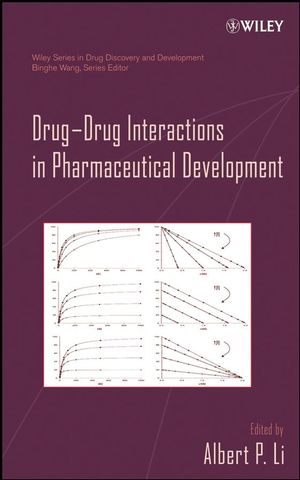Drug-Drug Interactions in Pharmaceutical DevelopmentISBN: 978-0-471-79441-7
Hardcover
264 pages
November 2007
 This is a Print-on-Demand title. It will be printed specifically to fill your order. Please allow an additional 10-15 days delivery time. The book is not returnable.
|
||||||
Contributors.
1 In Vitro Evaluation of Metabolic Drug–Drug Interactions: Concepts and Practice (Albert P. Li).
1.1 Introduction.
1.2 Mechanisms of Adverse Drug–Drug Interactions.
1.2.1 Pharmacological Interactions.
1.2.2 Pharmacokinetic Interactions.
1.3 Drug Metabolism.
1.3.1 Phase I Oxidation.
1.3.2 Phase II Conjugation.
1.4 CYP Isoforms.
1.5 Human In Vitro Experimental Systems for Drug Metabolism.
1.5.1 Hepatocytes.
1.5.2 Liver Postmitochondrial Supernatant (PMS).
1.5.3 Human Liver Microsomes.
1.5.4 Recombinant P450 Isoforms (rCYP).
1.5.5 Cytosol.
1.6 Mechanisms of Metabolic Drug–Drug Interactions.
1.7 Mechanism-Based Approach for Evaluation of Drug–Drug Interaction Potential.
1.7.1 Metabolic Phenotyping.
1.7.2 Evaluation of Inhibitory Potential for Drug-Metabolizing Enzymes.
1.7.3 Induction Potential for Drug-Metabolizing Enzymes.
1.8 Experimental Approaches for In Vitro Evaluation of Drug–Drug Interaction Potential.
1.8.1 Study 1: Metabolic Phenotyping 1—Metabolite Identification.
1.8.2 Study 2: Metabolic Phenotyping 2—Identification of Major Metabolic Pathways.
1.8.3 Study 3: Metabolic Phenotyping 3—Identification of P450 Isoform Pathways (P450 Phenotyping).
1.8.4 Study 4: CYP Inhibitory Potential.
1.8.5 Study 5: Enzyme Induction Potential.
1.8.6 Study 6: In Vitro Empirical Drug–Drug Interactions.
1.9 Data Interpretation.
1.9.1 Pathway Evaluation.
1.9.2 P450 Inhibition.
1.9.3 P450 Induction.
1.10 Conclusion.
References.
2 In Vitro Approaches to Anticipating Clinical Drug Interactions (Laurie P. Volak, David J. Greenblatt, and Lisa L. von Moltke).
2.1 In Vitro Systems for Human CYP450 Metabolism.
2.1.1 Incubation Buffer (pH and Ionic Strength).
2.1.2 MgCl2 and Cytochrome b5.
2.1.3 Nonspecific Binding.
2.1.4 Organic Solvents and Excipients.
2.2 Analysis of Data from In Vitro Systems.
2.2.1 Linear Transformation of Michaelis–Menten Equation (Lineweaver–Burk and Eadie–Hofstee).
2.2.2 Nonlinear Regression Analysis of Hyperbolic Kinetic Data.
2.2.3 Consideration of Non-Michaelis–Menten Kinetics.
2.3 Use of In Vitro Kinetic Data to Predict In Vivo Clearance.
2.3.1 Calculation of In Vitro (Predicted) Hepatic Clearance.
2.3.2 Comparison of In Vitro (Predicted) with In Vivo Hepatic Clearance.
2.4 Use of In Vitro Kinetic Data to Predict Drug–Drug Interactions.
2.4.1 Choice of Probe Substrates for Inhibition Studies.
2.4.2 Determining the Mechanism of CYP450 Inhibition.
2.4.3 Prediction of In Vivo Drug–Drug Inhibition Interactions from In Vitro Data.
2.5 Consideration of Non-CYP Enzymatic Systems.
2.5.1 Flavin-Containing Monooxygenase (FMO).
2.5.2 UDP-glucuronosyltransferase (UGT).
2.5.3 Sulfotransferase (SULT).
2.5.4 N-Acetyltransferase (NAT).
2.5.5 Methyltransferase.
2.5.6 Epoxidase Hydrolase.
2.5.7 Aldehyde Oxidase and Dehydrogenase.
2.5.8 Glutathione-S-transferase (GST).
2.6 Summary.
2.7 Acknowledgments.
References.
3 Inhibition of Drug-Metabolizing Enzymes and Drug–Drug Interactions in Drug Discovery and Development (R. Scott Obach).
3.1 Introduction.
3.2 Laboratory Approaches Inhibiting Drug-Metabolizing Enzymes.
3.2.1 Analytical Method.
3.2.2 Determination of Linearity of Velocity.
3.2.3 Substrate Saturation Experiment.
3.2.4 Reversible Inhibition Experiments: Ki.
3.2.5 Reversible Inhibition Experiments: IC50.
3.3 Selection of Substrates for Inhibition Experiments in Drug Metabolism.
3.4 Inhibition of Drug-Metabolizing Enzymes in Drug Discovery and Development.
3.4.1 Inhibition Experiments in Early Drug Discovery.
3.4.2 Inhibition Experiments in Late Drug Discovery.
3.4.3 Inhibition Experiments During Drug Development.
3.5 Summary.
References.
4 Mechanism-Based CYP Inhibition: Enzyme Kinetics, Assays, and Prediction of Human Drug–Drug Interactions (Magang Shou).
4.1 Kinetic Model for Mechanism-Based Inhibition.
4.2 Methodological Measurements of Kinetic Parameters.
4.3 Incubation.
4.3.1 CYP Isoform-Specific Assays.
4.3.2 General Incubation Procedure and Sample Preparation.
4.3.3 LC-MS–MS Analysis.
4.3.4 Data Analysis.
4.4 Prediction of Human DDIs from In Vitro MBI Data.
4.5 Acknowledgments.
References.
5 Genomic Approaches To Drug–Drug Interactions (Yi Yang and Jeffrey F. Waring).
5.1 Introduction.
5.2 DNA Microarrays.
5.2.1 Array Platforms.
5.2.2 Gene Expression Profiling Using Microarray.
5.2.3 Genotyping Using Microarray.
5.3 Genomic Application Toward the Prediction of DDIs.
5.3.1 Gene Expression Profiling of Compound Mixtures.
5.3.2 Expression Profiling of DMEs and Transporters.
5.3.3 Identification of Gene Expression Patterns Indicative of DDIs.
5.4 Genomics Approach to Decipher the Molecular Basis of DDI: Nuclear Receptors.
5.5 Genomic Approaches to Address the Genetic Variability in DDIs.
5.6 Conclusion.
References.
6 Transporters and Drug Interactions (Yoshihisa Shitara, Toshiharu Horie, and Yuichi Sugiyama)
6.1 Introduction.
6.2 Interactions Involving Liver Transporters.
6.2.1 Role of Transporters in the Biliary Excretion of Drugs.
6.2.2 Transporter-Mediated DDIs in the Process of Hepatobilary Excretion.
6.2.3 Transporters as a Determinant of Metabolic Rate.
6.3 Interactions in Intestine Transporters.
6.3.1 Role of Transporters in Intestinal Absorption.
6.3.2 Examples of Transporter-Mediated DDIs in the Process of Intestinal Absorption.
6.4 Drug Toxicity Involving Drug Transporters.
6.5 Drugs that Affect the Expression or Localization of Transporters.
6.6 Conclusion.
References.
7 Transporter-Mediated Drug Interactions: Molecular Mechanisms and Clinical Implications (Jiunn H. Lin).
7.1 Introduction.
7.2 Tissue Distribution and Cellular Location of Transporters.
7.2.1 Small Intestine.
7.2.2 Liver.
7.2.3 Kidney.
7.2.4 Brain.
7.3 Molecular Mechanisms for Transporter Inhibition and Induction.
7.3.1 Inhibition of Transporters.
7.3.2 Induction of Transporters.
7.4 Drug Interactions Caused by Transporter Inhibition and Induction.
7.4.1 Direct Evidence.
7.4.2 Circumstantial Evidence.
7.5 Clinical Significance of Transporter-Mediated Drug Interactions.
7.6 Conclusion.
References.
8 Recent Case Studies of Clinically Significant Drug–Drug Interactions and the Limits of In Vitro Prediction Methodology (René H. Levy, Isabelle Ragueneau-Majlessi, and Carol Collins).
8.1 Introduction.
8.2 Case Studies.
8.2.1 Interaction Between Repaglinide and Gemfibrozil þ Itraconazole.
8.2.2 Interaction Between Ramelteon and Fluvoxamine.
References.
9 U.S. Regulatory Perspective: Drug–Drug Interactions (John Strong and Shiew-Mei Huang).
9.1 Introduction.
9.2 An Integrated Approach.
9.3 Methods for Evaluating Metabolic Clearance In Vitro.
9.3.1 CYP Reaction Phenotyping.
9.3.2 CYP Inhibition.
9.3.3 CYP Induction.
9.3.4 Other Metabolic Enzymes.
9.3.5 Transporters.
9.3.6 GLP Versus Non-GLP Studies.
9.4 In Vivo Approaches.
9.4.1 Study Design.
9.4.2 Data Analysis and Sample Size Consideration.
9.4.3 Classification of Inhibitors and Labeling Considerations.
9.4.4 Cocktail Approaches.
9.4.5 P-gp and Other Transporters.
9.5 Clinical Cases.
9.6 Regulatory Considerations.
9.7 Labeling.
9.8 Summary.
References.
10 Herbal Drug Interactions—A Canadian Perspective (Brian C. Foster)
10.1 Introduction.
10.2 Interaction Risk Determination.
10.3 NHP Products.
10.3.1 NHP Characterization.
10.4 Disposition.
10.5 PD and PK interactions.
10.5.1 Choice of Substance Concentration Range.
10.5.2 Role of Animal Studies.
10.5.3 Human Clinical Studies.
10.6 Action.
References.
Index.
Wiley Series in Drug Discovery and Development.



